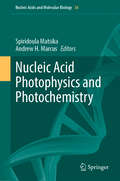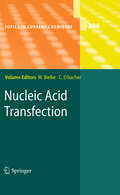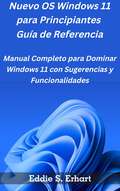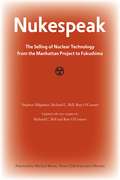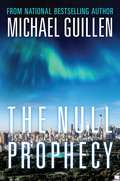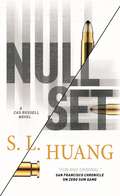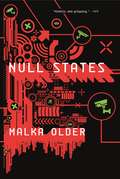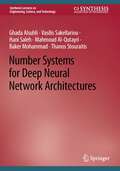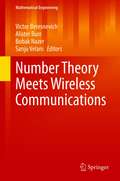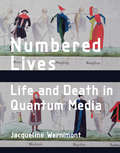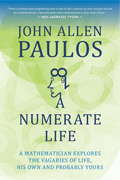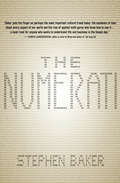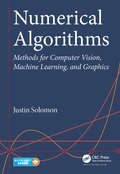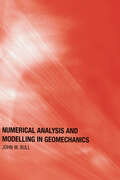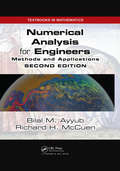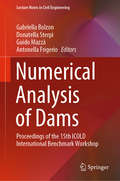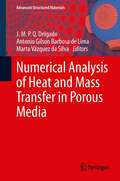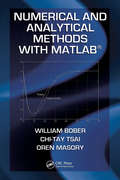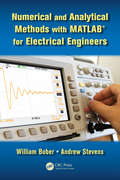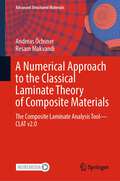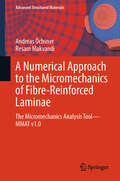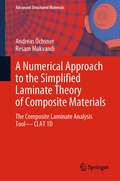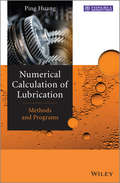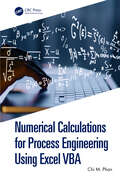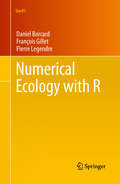- Table View
- List View
Nucleic Acid Photophysics and Photochemistry (Nucleic Acids and Molecular Biology #36)
by Spiridoula Matsika Andrew H. MarcusThis volume focuses on recent advancements in our current understanding of nucleic acid photochemistry and its relationship to biologically relevant phenomena. Understanding the photophysical properties of nucleic acids is an area of longstanding and active research. Over the years, the field has greatly benefitted from steady advances in spectroscopic techniques and computational methods to study molecular excited states, which have facilitated detailed studies of the behavior of nucleic acids and their components after they absorb light. Experiments performed on ultrafast time scales (femtoseconds - picoseconds) have permitted the accurate determination of excited state lifetimes, while computational studies have provided detailed microscopic information about the mechanisms involved. As our understanding of the fundamental photophysics of nucleic acids has advanced, current studies now focus on systems of higher complexity, and introduce novel optical techniques to investigate the interactions between nucleic acids and proteins. Spectroscopic studies of nucleic acids, particularly nucleic acid constructs labeled with optical probes, can yield richly detailed information important to molecular biology, biochemistry and biophysics. This book is a must-read for anyone interested in the photophysical properties of nucleic acids and their role in biologically relevant phenomena.
Nucleic Acid Transfection
by Christoph Erbacher Wolfgang BielkeGene Delivery into Mammalian Cells: An Overview on Existing Approaches Employed In Vitro and In Vivo, by Peter Hahn and Elizabeth Scanlan * Strategies for the Preparation of Synthetic Transfection Vectors, by Asier Unciti-Broceta, Matthew N. Bacon, and Mark Bradley * Cationic Lipids: Molecular Structure/Transfection Activity Relationships and Interactions with Biomembranes, by Rumiana Koynova and Boris Tenchov * Hyperbranched Polyamines for Transfection, by Wiebke Fischer, Marcelo Calderon, and Rainer Haag * Carbohydrate Polymers for Nonviral Nucleic Acid Delivery, by Antons Sizovs, Patrick M. McLendon, Sathya Srinivasachari, and Theresa M. Reineke * Cationic Liposome-Nucleic Acid Complexes for Gene Delivery and Silencing: Pathways and Mechanisms for Plasmid DNA and siRNA, by Kai K. Ewert, Alexandra Zidovska, Ayesha Ahmad, Nathan F. Bouxsein, Heather M. Evans, Christopher S. McAllister, Charles E. Samuel, and Cyrus R. Safinya * Chemically Programmed Polymers for Targeted DNA and siRNA Transfection, by Eveline Edith Salcher and Ernst Wagner * Photochemical Internalization: A New Tool for Gene and Oligonucleotide Delivery, by Kristian Berg, Maria Berstad, Lina Prasmickaite, Anette Weyergang, Pål K. Selbo, Ida Hedfors, and Anders Høgset *Visualizing Uptake and Intracellular Trafficking of Gene Carriers by Single-Particle Tracking, by N. Ruthardt and C. Bräuchle
Nuevo OS Windows 11 para Principiantes Guía de Referencia: Manual Completo para Dominar Windows 11 con Sugerencias y Funcionalidades
by Eddie E. ErhartCon la última iteración en la larga lista de sistemas operativos de Microsoft llega el Windows 11, que es sin duda el paquete completo de todo lo que siempre quiso en un sistema operativo para PC. Con este fantástico software ya en el mercado, no es de extrañar que quiera hacerse con una copia y dominarlo en el menor tiempo posible. La Guía de referencia para principiantes del nuevo sistema operativo Windows 11 le proporciona información valiosa respaldada por explicaciones bien detalladas, todo ello con el fin de asegurarse de que se pone manos a la obra. Este viaje comienza con una introducción a las características que hacen único a Windows 11, y luego nos adentramos en la sala de máquinas de lo que hace funcionar al nuevo sistema operativo. A lo largo de este viaje, se le presentará lo siguiente: Nuevas características de Windows 11 Descarga e instalación de Windows 11 Cómo navegar por Windows 11 Cómo localizar sus archivos Configurar varias cuentas Personalizar los widgets Personalización de temas y fuentes Cómo utilizar Microsoft Teams Conectarse a una red Wi-Fi Mejorar la productividad del Explorador de archivos Crear particiones en Windows 11 Activar la configuración de privacidad La sinergia entre Windows 11 y el sistema operativo Android Y mucho más.
Nukespeak
by Rory O'Connor Richard C. Bell Stephen HilgartnerA language of euphemism and distortion-a language like "newspeak" from George Orwell's 1984-has profoundly shaped public debate about nuclear technology since its inception. After World War II, nuclear developers used information-management techniques, including official secrecy and public relations, to promote what one called the "sunny side of the atom"-energy "too cheap to meter" that would supposedly power a new Golden Age. Such euphoric visions set the stage for one of the most extraordinary public-relations efforts in history: the selling of nuclear technology to the American public.The original edition of Nukespeak, published by Sierra Club Books in 1982, was conceived in the wake of the first great nuclear plant accident at Three Mile Island. Breaking through the linguistic filter of the nuclear mindset, it carefully documented how nuclear developers confused their hopes with reality, covered up damaging information, harassed and dismissed scientists who disagreed with official policy, and generated false or misleading statistics to bolster their assertions.Sadly, these developers also failed to learn from their mistakes-as this updated 30th anniversary edition of the book makes abundantly clear. Examining the critical events of the last three decades-including Chernobyl; nuclear proliferation thanks to the fiction of "Atoms for Peace"; the campaign to re-brand nuclear power as a clean, green solution to global warming; and the still-unfolding disaster at Japan's Fukushima power plant-the new edition argues persuasively that "nukespeak" and the nuclear mindset continue to dominate public debate about nuclear weapons and nuclear power in a continuing attempt to seduce us into accepting the unthinkable.
The Null Prophecy
by Michael GuillenSpace weather scientists in Northeast Canada have spotted holes opening in Earth's magnetosphere. Now a massive, deadly eruption of solar radiation is barreling toward the planet at one million miles per hour. <P><P>With only three days before impact, the president of the United States desperately turns to two unlikely heroes for help: inventor Calder Sinclair and physicist-turned-news-correspondent Allie Armendariz. <P><P> As they and the world focus on the looming disaster from space, someone is secretly plotting to wreak havoc globally on the ground. If successful, the fiendish plan will hurl modern civilization back to the Nineteenth Century. Guillen skillfully weaves heart-racing suspense with deeper questions about the profound consequences of scientific innovation, both intended and unintended. As his heroes search for answers, they run headlong into questions about human origins and the meaning and purpose of life and death. <P><P> Racing the clock, Calder and Allie battle personal demons (as well as each other), all the while inching closer to a staggering truth foretold in ancient literature that decisively spells out the world's future—the Null Prophecy.
Null Set: A Cas Russell Novel (Cas Russell #2)
by S. L. HuangS. L. Huang's Null Set is the breakout sf thriller for fans of John Scalzi and Greg RuckaMath-genius mercenary Cas Russell has decided to Fight Crime(tm). After all, with her extraordinary mathematical ability, she can neuter bombs or out-shoot an army. And the recent outbreak of violence in the world’s cities is Cas’s fault—she’s the one who crushed the organization of telepaths keeping the world’s worst offenders under control.But Cas’s own power also has a history, one she can’t remember—or control. One that's creeping into her mind and fracturing her sanity...just when she’s gotten herself on the hit list of every crime lord on the West Coast. And her best, only, sociopathic friend. Cas won’t be able to save the world. She might not even be able to save herself.At the Publisher's request, this title is being sold without Digital Rights Management Software (DRM) applied.
Null States: A Novel
by Malka Older"Kinetic and gripping" —NPR on InfomocracyNull States continues Campbell Award finalist Malka Older's Centenal Cycle, the near-future science fiction trilogy beginning with Infomocracy• The book The Huffington Post called "one of the greatest literary debuts in recent history"• Named one of the best books of the year by The Washington Post, The Verge, Flavorwire, Kirkus, and Book Riot• A Locus Award Finalist for Best First NovelThe future of democracy is about to implode.After the last controversial global election, the global infomocracy that has ensured thirty years of world peace is fraying at the edges. As the new Supermajority government struggles to establish its legitimacy, agents of Information across the globe strive to keep the peace and maintain the flows of data that feed the new world order. In the newly-incorporated DarFur, a governor dies in a fiery explosion. In Geneva, a superpower hatches plans to bring microdemocracy to its knees. In Central Asia, a sprawling war among archaic states threatens to explode into a global crisis. And across the world, a shadowy plot is growing, threatening to strangle Information with the reins of power.At the Publisher's request, this title is being sold without Digital Rights Management Software (DRM) applied.
Number Systems for Deep Neural Network Architectures (Synthesis Lectures on Engineering, Science, and Technology)
by Ghada Alsuhli Vasilis Sakellariou Hani Saleh Mahmoud Al-Qutayri Baker Mohammad Thanos StouraitisThis book provides readers a comprehensive introduction to alternative number systems for more efficient representations of Deep Neural Network (DNN) data. Various number systems (conventional/unconventional) exploited for DNNs are discussed, including Floating Point (FP), Fixed Point (FXP), Logarithmic Number System (LNS), Residue Number System (RNS), Block Floating Point Number System (BFP), Dynamic Fixed-Point Number System (DFXP) and Posit Number System (PNS). The authors explore the impact of these number systems on the performance and hardware design of DNNs, highlighting the challenges associated with each number system and various solutions that are proposed for addressing them.
Number Theory Meets Wireless Communications (Mathematical Engineering)
by Victor Beresnevich Alister Burr Bobak Nazer Sanju VelaniThis volume explores the rich interplay between number theory and wireless communications, reviewing the surprisingly deep connections between these fields and presenting new research directions to inspire future research. The contributions of this volume stem from the Workshop on Interactions between Number Theory and Wireless Communication held at the University of York in 2016. The chapters, written by leading experts in their respective fields, provide direct overviews of highly exciting current research developments. The topics discussed include metric Diophantine approximation, geometry of numbers, homogeneous dynamics, algebraic lattices and codes, network and channel coding, and interference alignment. The book is edited by experts working in number theory and communication theory. It thus provides unique insight into key concepts, cutting-edge results, and modern techniques that play an essential role in contemporary research. Great effort has been made to present the material in a manner that is accessible to new researchers, including PhD students. The book will also be essential reading for established researchers working in number theory or wireless communications looking to broaden their outlook and contribute to this emerging interdisciplinary area.
Numbered Lives: Life and Death in Quantum Media (Media Origins)
by Jacqueline WernimontA feminist media history of quantification, uncovering the stories behind the tools and technologies we use to count, measure, and weigh our lives and realities. Anglo-American culture has used media to measure and quantify lives for centuries. Historical journal entries map the details of everyday life, while death registers put numbers to life's endings. Today we count our daily steps with fitness trackers and quantify births and deaths with digitized data. How are these present-day methods for measuring ourselves similar to those used in the past? In this book, Jacqueline Wernimont presents a new media history of western quantification, uncovering the stories behind the tools and technologies we use to count, measure, and weigh our lives and realities. Numbered Lives is the first book of its kind, a feminist media history that maps connections not only between past and present-day “quantum media” but between media tracking and long-standing systemic inequalities. Wernimont explores the history of the pedometer, mortality statistics, and the census in England and the United States to illuminate the entanglement of Anglo-American quantification with religious, imperial, and patriarchal paradigms. In Anglo-American culture, Wernimont argues, counting life and counting death are sides of the same coin—one that has always been used to render statistics of life and death more valuable to corporate and state organizations. Numbered Lives enumerates our shared media history, helping us understand our digital culture and inheritance.
A Numerate Life
by John Allen PaulosEmploying intuitive ideas from mathematics, this quirky "meta-memoir" raises questions about our lives that most of us don't think to ask, but arguably should: What part of memory is reliable fact, what part creative embellishment? Which favorite presuppositions are unfounded, which statistically biased? By conjoining two opposing mindsets--the suspension of disbelief required in storytelling and the skepticism inherent in the scientific method--bestselling mathematician John Allen Paulos has created an unusual hybrid, a composite of personal memories and mathematical approaches to re-evaluating them.Entertaining vignettes from Paulos's biography abound--ranging from a bullying math teacher and a fabulous collection of baseball cards to romantic crushes, a grandmother's petty larceny, and his quite unintended role in getting George Bush elected president in 2000. These vignettes serve as springboards to many telling perspectives: simple arithmetic puts life-long habits in a dubious new light; higher dimensional geometry helps us see that we're all rather peculiar; nonlinear dynamics explains the narcissism of small differences cascading into very different siblings; logarithms and exponentials yield insight on why we tend to become bored and jaded as we age; and there are tricks and jokes, probability and coincidences, and much more.For fans of Paulos or newcomers to his work, this witty commentary on his life--and yours--is fascinating reading.From the Trade Paperback edition.
The Numerati: How They'll Get My Number And Yours
by Stephen BakerLearn how the crisis over digital privacy and manipulation evolved in this &“utterly fascinating&” look at the growth of data mining and analysis (Seattle Post-Intelligencer). Award-winning journalist Stephen Baker traces the rise of the &“global math elite&”: computer scientists who invent ways to not only record our behavior, but also to predict and alter it. Nowadays, we don&’t need to be online to create a digital trail; we do it simply by driving through an automated tollbooth or shopping with a credit card. As massive amounts of information are collected, sifted, and analyzed, we all become targets of those who want to influence everything from what we buy to how we vote. Clear and &“highly readable,&” The Numerati is a look at the origins of our present-day world, the possibilities of the future, and those who—whether with good or bad intentions—profile us as workers, consumers, citizens, or potential terrorists (The Wall Street Journal).
Numerical Algorithms: Methods for Computer Vision, Machine Learning, and Graphics
by Justin SolomonNumerical Algorithms: Methods for Computer Vision, Machine Learning, and Graphics presents a new approach to numerical analysis for modern computer scientists. Using examples from a broad base of computational tasks, including data processing, computational photography, and animation, the textbook introduces numerical modeling and algorithmic desig
Numerical Analysis and Modelling in Geomechanics
by John W. BullIn geomechanics, existing design methods are very much dependent upon sophisticated on-site techniques to assess ground conditions. This book describes numerical analysis, computer simulation and modelling that can be used to answer some highly complex questions associated with geomechanics. The contributors, who are all international experts in th
Numerical Analysis for Engineers: Methods and Applications, Second Edition (Textbooks In Mathematics Ser.)
by Bilal Ayyub Richard H. McCuenNumerical Analysis for Engineers: Methods and Applications demonstrates the power of numerical methods in the context of solving complex engineering and scientific problems. The book helps to prepare future engineers and assists practicing engineers in understanding the fundamentals of numerical methods, especially their applications, limitations,
Numerical Analysis of Dams: Proceedings of the 15th ICOLD International Benchmark Workshop (Lecture Notes in Civil Engineering #91)
by Gabriella Bolzon Donatella Sterpi Guido Mazzà Antonella FrigerioThis book gathers contributions from the 15th ICOLD Benchmark Workshop on Numerical Analysis of Dams. The workshop provided an opportunity for engineers, researchers and operators to present and exchange their experiences and the latest advances in numerical modelling in the context of the design, performance and monitoring of dams. Covering various aspects of computer analysis tools and safety assessment criteria, and their development over recent decades, the book is a valuable reference resource for those in the engineering community involved in the safety, planning, design, construction, operation and maintenance of dams.
Numerical Analysis of Heat and Mass Transfer in Porous Media
by Antonio Gilson Lima J.M.P.Q. Delgado Marta Vázquez SilvaThe purpose of 'Numerical Analysis of Heat and Mass Transfer in Porous Media' is to provide a collection of recent contributions in the field of computational heat and mass transfer in porous media. The main benefit of the book is that it discusses the majority of the topics related to numerical transport phenomenon in engineering (including state-of-the-art and applications) and presents some of the most important theoretical and computational developments in porous media and transport phenomenon domain, providing a self-contained major reference that is appealing to both the scientists, researchers and the engineers. At the same time, these topics encounter of a variety of scientific and engineering disciplines, such as chemical, civil, agricultural, mechanical engineering, etc. The book is divided in several chapters that intend to be a resume of the current state of knowledge for benefit of professional colleagues.
Numerical and Analytical Methods with MATLAB (Applied and Computational Mechanics)
by William Bober Chi-Tay Tsai Oren MasoryNumerical and Analytical Methods with MATLAB presents extensive coverage of the MATLAB programming language for engineers. It demonstrates how the built-in functions of MATLAB can be used to solve systems of linear equations, ODEs, roots of transcendental equations, statistical problems, optimization problems, control systems problem
Numerical and Analytical Methods with MATLAB for Electrical Engineers (Applied and Computational Mechanics)
by William Bober Andrew StevensCombining academic and practical approaches to this important topic, Numerical and Analytical Methods with MATLAB for Electrical Engineers is the ideal resource for electrical and computer engineering students. Based on a previous edition that was geared toward mechanical engineering students, this book expands many of the concepts presented in tha
A Numerical Approach to the Classical Laminate Theory of Composite Materials: The Composite Laminate Analysis Tool—CLAT v2.0 (Advanced Structured Materials #189)
by Andreas Öchsner Resam MakvandiThis book first provides a systematic and thorough introduction to the classical laminate theory for composite materials based on the theory for plane elasticity elements and classical (shear-rigid) plate elements. The focus is on unidirectional lamina which can be described based on orthotropic constitutive equations and their composition to layered laminates. In addition to the elastic behavior, failure is investigated based on the maximum stress, maximum strain, Tsai-Hill, and the Tsai-Wu criteria.The solution of the fundamental equations of the classical laminate theory is connected with extensive matrix operations, and many problems require in addition iteration loops. Thus, a classical hand calculation of related problems is extremely time consuming. In order to facilitate the application of the classical laminate theory, we decided to provide a Python-based computational tool, the so-called Composite Laminate Analysis Tool (CLAT) to easily solve some standard questions from the context of fiber-reinforced composites. The tool runs in any standard web browser and offers a user-friendly interface with many post-processing options. The functionality comprises stress and strain analysis of lamina and laminates, derivation of off-axis elastic properties of lamina, and the failure analysis based on different criteria.
A Numerical Approach to the Micromechanics of Fibre-Reinforced Laminae: The Micromechanics Analysis Tool—MMAT v1.0 (Advanced Structured Materials #218)
by Andreas Öchsner Resam MakvandiThis book treats the micromechanics of laminae, i.e., the prediction of the macroscopic mechanical lamina properties based on the mechanical properties of the constituents, i.e., fibers and matrix. The focus is on unidirectional lamina which can be described based on orthotropic constitutive equations. In detail, predictions for the modulus of elasticity in and transverse to the fiber direction, the major Poisson’s ratio, as wells as the in-plane shear modulus are provided. The mechanics of materials approach, the elasticity solutions with contiguity after Tsai, and the Halpin-Tsai relationships, are presented in detail. Composite materials, especially fiber-reinforced composites, are gaining increasing importance since they can overcome the limits of many structures based on classical engineering materials. Particularly the combination of a matrix with fibers provides far better properties than the single constituents alone. A typical basic layer, the so-called lamina, can be composed of unidirectional fibers which are embedded in a matrix. In a second step, layers of laminae may be stacked under different fiber angles to a so-called laminate, which reveals—depending on the stacking sequence—different types of anisotropy/isotropy. A Python-based computational tool is provided, the so-called Micromechanics Analysis Tool (MMAT v1.0) to easily predict the elastic properties. The tool runs in any standard web browser and offers a user-friendly interface with many graphical representations of the elastic properties as a function of the fiber volume fraction.
A Numerical Approach to the Simplified Laminate Theory of Composite Materials: The Composite Laminate Analysis Tool—CLAT 1D (Advanced Structured Materials #202)
by Andreas Öchsner Resam MakvandiA typical approach to treat composite materials, which are composed of layered unidirectional lamina, is the so-called classical laminate theory (CLT). This theory is based on the theory for plane elasticity elements and classical (shear-rigid) plate elements under the assumption of orthotropic constitutive equations. The solution of the fundamental equations of the classical laminate theory is connected with extensive matrix operations and many problems require in addition iteration loops.This two-dimensional approach and the underlying advanced continuum mechanical modeling might be very challenging for some students, particularly at universities of applied sciences. Thus, a reduced approach, the so-called simplified classical laminate theory (SCLT), has been recently proposed. The idea was to use solely isotropic one-dimensional elements, i.e., a superposition of bar and beam elements, to introduce the major calculation steps of the classical laminate theory. Understanding this simplified theory is much easier and the final step it to highlight the differences when moving to the general two-dimensional case.This monograph first provides a systematic and thorough introduction to the simplified laminate theory based on the theory for bars and classical beam plate elements. The focus is on stacking of isotropic layers to simplified laminates. In addition to the elastic behavior, failure is investigated based on the maximum stress, maximum strain, Tsai-Hill, and the Tsai-Wu criteria. We provide a Python-based computational tool, the so-called Composite Laminate Analysis Tool (CLAT 1D) to easily solve some standard questions from the context of fiber reinforced composites. The tool runs in any standard web browser and offers a user-friendly interface with many post-processing options. The functionality comprises stress and strain analysis of simplified lamina and laminates and the failure analysis based on different criteria.
Numerical Calculation of Lubrication: Methods and Programs
by Ping HuangFocusing on basic lubrication problems this book offers specific engineering applications. The book introduces methods and programs for the most important lubrication problems and their solutions. It is divided into four parts. The first part is about the general solving methods of the Reynolds equation, including solutions of Reynolds equations with different conditions and their discrete forms, such as a steady-state incompressible slider, journal bearing, dynamic bearing, gas bearing and grease lubrication. The second part gives the ‘energy equation solution’. The third part introduces methods and programs for elasto-hydrodynamic lurbication, which links the Reynolds equation with the elastic deformation equation. The final part presents application lubrication programs used in engineering. Provides numerical solution methodologies including appropriate software for the hydrodynamic and elasto-hydrodynamic lubrication of bearings Offers a clear introduction and orientation to all major engineering lubrication problems and their solutions Presents numerical programs for specific applications in engineering, with special topics including grease-lubricated bearings and gas bearings Equips those working in tribology and those new to the topic with the fundamental tools of calculation Downloadable programs are available at the companion website With an emphasis on clear explanations, the text offers a thorough understanding of the numerical calculation of lubrication for graduate students on tribology and engineering mechanics courses, with more detailed materials suitable for engineers. This is an accessible reference for senior undergraduate students of tribology and researchers in thin-film fluid mechanics.
Numerical Calculations for Process Engineering Using Excel VBA
by Chi M. PhanNumerical Calculations for Process Engineering Using Excel VBA provides numerical treatment of process engineering problems with VBA programming and Excel spreadsheets. The problems are solving material and energy balances, optimising reactors and modelling multiple-factor processes. The book includes both basic and advanced codes for numerical calculations. The basic methods are presented in different variations tailored to particular applications. Some macros are combined with each other to solve engineering problems. Examples include combining the bisection method and binary search to optimise an implicit correlation, combining golden section search with Euler’s method to optimise a reactor and combining bisection code and Euler’s method to solve steady-state heat distribution. The text also includes nonconventional examples such as harmony search and network analysis. The examples include solutions to common engineering problems such as adiabatic flame temperature, plug flow reactor conversion, batch reactor, heat diffusion and pinch analysis of heat exchanger networks. The VBA code is presented with mathematical equations and flowcharts, enabling the audience to adopt the solutions to different problems. The book contains many demonstrations of numerical techniques to guide users. It also includes useful summaries of VBA commands/functions and Excel-predefined functions accessible in VBA. While the book is developed primarily for undergraduate students, the book is a helpful resource for postgraduate students and engineers.
Numerical Ecology with R
by Francois Gillet Daniel Borcard Pierre LegendreNumerical Ecology with R provides a long-awaited bridge between a textbook in Numerical Ecology and the implementation of this discipline in the R language. After short theoretical overviews, the authors accompany the users through the exploration of the methods by means of applied and extensively commented examples. Users are invited to use this book as a teaching companion at the computer. The travel starts with exploratory approaches, proceeds with the construction of association matrices, then addresses three families of methods: clustering, unconstrained and canonical ordination, and spatial analysis. All the necessary data files, the scripts used in the chapters, as well as the extra R functions and packages written by the authors, can be downloaded from a web page accessible through the Springer web site(http://adn.biol.umontreal.ca/~numericalecology/numecolR/). This book is aimed at professional researchers, practitioners, graduate students and teachers in ecology, environmental science and engineering, and in related fields such as oceanography, molecular ecology, agriculture and soil science, who already have a background in general and multivariate statistics and wish to apply this knowledge to their data using the R language, as well as people willing to accompany their disciplinary learning with practical applications. People from other fields (e.g. geology, geography, paleoecology, phylogenetics, anthropology, the social and education sciences, etc.) may also benefit from the materials presented in this book. The three authors teach numerical ecology, both theoretical and practical, to a wide array of audiences, in regular courses in their Universities and in short courses given around the world. Daniel Borcard is lecturer of Biostatistics and Ecology and researcher in Numerical Ecology at Université de Montréal, Québec, Canada. François Gillet is professor of Community Ecology and Ecological Modelling at Université de Franche-Comté, Besançon, France. Pierre Legendre is professor of Quantitative Biology and Ecology at Université de Montréal, Fellow of the Royal Society of Canada, and ISI Highly Cited Researcher in Ecology/Environment.
